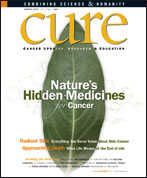Publication
Article
CURE
Is It Time to Change the Design of Clinical Trials?
Author(s):
Some cancer researchers are questioning whether clinical trial designs should be updated.
No one would argue the current design of clinical trials in the United States isn’t a big improvement over history, since early experiments in medicine involved unscientific and inefficient methods for assigning patients to treatments.
“Up until about 60 years ago—when the randomized trial came into existence—the standards in medical research were shoddy at best,” says Donald Berry, PhD, chairman of the department of biostatistics at M.D. Anderson Cancer Center in Houston. “Information was collected by anecdote and superstition more than science.”
But some leading cancer researchers find current designs outdated. “It’s clear the current designs are inadequate, particularly in cancers in which we desperately need to make progress more rapidly,” says Francis Giles, MD, chief of developmental therapeutics within the department of leukemia at M.D. Anderson. “We certainly can do better.”
The statistical method used almost exclusively to design and monitor clinical trials is called the frequentist method. These trials include a set number of patients randomized to one of two or more treatment groups and is conducted for a pre-determined length of time, with results assessed at select endpoints. “But at the end of these trials, you usually wish you had done something different,” says Dr. Berry.
Drs. Berry and Giles believe Bayesian trials—studies that allow for changes in the trial as it progresses—are a major step forward. The concept is certainly not new, having been named after the Reverend Thomas Bayes, a Presbyterian minister and mathematician, who outlined the method in an article published in 1763. In a Bayesian-based trial, the study adapts to statistical information created during the course of the trial. Before the trial starts, investigators design a flow chart of actions if certain events become statistically dominant.
“In Bayesian trials, you have to consider all the possibilities ahead of time and plan for alternatives,” explains Dr. Berry, who wrote about the Bayesian method in the January 2006 issue of Nature Reviews Drug Discovery. For example, if it becomes statistically clear that one treatment group is having more success, fewer new patients are recruited into the less-favorable group and those currently in that group can switch or choose another study altogether. Similarly, if a treatment appears to be superior at a particular dose, other doses are phased out. And if serious toxicity arises in a treatment, patients migrate to another treatment or dose. By declaring a success or failure earlier, Dr. Berry says the result is more likely to be statistically accurate. Frequentist trials almost never use information accrued during the trial to affect the course of the study.
Dr. Berry says the traditional trial method has had enormous and appropriate impacts in medical research. “I don’t want to lose that, but there are problems with it.” So far, more than 200 Bayesian-based clinical trials have been proposed or conducted at M.D. Anderson, and other researchers are embracing the concept, including the Cancer and Leukemia Group B research group.
While the Food and Drug Administration accepts Bayesian-based clinical trials when assessing the safety and efficacy of new medical devices, only one drug—the heart medication Pravigard PAC—has ever been approved based on the Bayesian approach. But movements are afoot at the FDA for using these study designs for drug approvals.
Janet Woodcock, MD, the FDA’s deputy commissioner for operations, says the FDA believes Bayesian approaches should be incorporated into clinical trial design for drug testing because of the targeted therapy boom. “The trial approaches we use now are probably not the best ones for the new science we are bringing to cancer.” She points to Tarceva (erlotinib) and Iressa (gefitinib), both of which treat lung cancer, as examples. “We put patients into a study and find that 10 percent benefit. But we don’t know which 10 percent. What we want to do is figure out in advance who benefits and not expose those who don’t.”
An important missing link, she says, is the availability of diagnostic tests that can tell in advance of therapy what cancer pathways are active in a particular patient’s disease. “We [at the FDA] do not want to be a roadblock, but if we don’t have the tools to know who can benefit from a drug, we will not be able to approve new drugs,” says Dr. Woodcock.
“I see no rationale to further delay moving to these designs,” says Dr. Giles, who is currently involved in eight Bayesian-based leukemia studies. “They are more ethical, more patient-friendly, more conserving of resources, more statistically desirable. I think the next big issue is to get the FDA to accept them as the basis for new drug approvals.”






